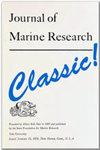帕梅卡山帕德莱甘村海域 Chaetoceros 属的鉴定
IF 0.5
4区 地球科学
Q3 Earth and Planetary Sciences
引用次数: 0
摘要
这是海洋中最常见的浮游植物。Chaetoceros属于属于杆菌类的硅藻组。在海洋中,这种物种是科普达的天然食物,科普达是一种浮游动物。而渔业养殖场则被用作天然的幼虫和虾幼虫的饲料。此外,chaetoceros物种属于sa探测器组,该组织是水被污染的生物指标,因此它们在海洋中的存在是相当重要的。本研究的目的是确定chaetoceros属中的浮游植物,这些浮游植物在渔业养殖中发挥着重要作用。这项研究涉及到在Padelegan pame难民村的海流中,在水体表面(0-50厘米)处采集海水样本和浮游植物。抽样时间在上午、中午和下午进行,重复了两次。使用10微米的浮游生物网。用10倍剂量的奥林巴斯BX41生物识别浮游植物。根据这项研究,已经发现了12种Chaetoceros物种,数量超过700 - 9100个ind/L。夜间没有发现变色藻,因为微藻生长因子是阳光。进入水中的阳光越多,浮游植物就越分散。Chaetoceros sp是一种在海洋水域发现的普通浮游生物。硅藻属于硅藻组,属于杆菌类。在海洋中,这种物种是一种天然的浮游动物食物。在水族中,它被用作天然的食物和拉维虾。此外,chaetoceros物种被包括在萨普罗斯集团,这是一个多民族的生物特征,所以他们在海上的表现是非常重要的。这项研究的目的是确定海洋文化中重要作用的chaetoceros属的浮游生物物种。这项研究的结果是在Padelegan pame难民村的海面上采集水中30 -50厘米的水浮游生物样本。抽样时间是在早上、下午和晚上,带着两份复印件。用的是浮游生物网,里面有10个微点的大小。用10倍放大镜进行植物浮游生物识别。根据结果,有12个Chaetoceros物种与700 - 9100磅的abundance一起被发现。晚上,没有chaetoceros物种被发现,因为微智能生长的有限因素是阳光。更多的阳光照射在水面上,更多的植物浮游生物分散在水面上。本文章由计算机程序翻译,如有差异,请以英文原文为准。
Identifikasi Genus Chaetoceros di Perairan Laut Desa Padelegan Pamekasan
Chaetoceros sp. merupakan fitoplankton yang banyak ditemukan di perairan laut. Chaetoceros termasuk dalam kelompok Diatom dengan kelas Bacillariophyceae. Di laut spesies ini merupakan makanan alami dari Copepoda, salah satu spesies zooplankton. Sedangkan pada budidaya perikanan digunakan sebagai pakan alami Rotifer dan larva udang. Selain itu, spesies chaetoceros termasuk dalam kelompok saprobe yang berperan sebagai indikator biologis perairan yang tercemar sehingga keberadaannya di laut cukup penting. Tujuan penelitian ini adalah untuk mengidentifikasi jenis fitoplankton dari genus chaetoceros yang mempunyai fungsi penting dalam budidaya perikanan. Penelitian dilakukan dengan mengambil sampel air laut dan fitoplankton pada permukaan badan air (0-50 cm) di perairan laut Desa Padelegan Pamekasan. Waktu pengambilan sampel dilakukan pada pagi, siang dan sore hari dengan dua kali pengulangan. Menggunakan jaring plankton dengan ukuran mesh 10 mikron. Identifikasi fitoplankton menggunakan mikroskop Olympz BX41 dengan perbesaran 10x. Berdasarkan hasil penelitian, telah ditemukan 12 spesies Chaetoceros dengan kelimpahan 700–9100 ind/L. Pada malam hari tidak ditemukan spesies chaetoceros karena faktor pembatas pertumbuhan mikroalga adalah sinar matahari. Semakin banyak sinar matahari yang masuk ke perairan, maka semakin banyak pula fitoplankton yang tersebar. Chaetoceros sp is a phytoplankton commonly found in marine waters. Chaetoceros belongs to the Diatom group with the class of Bacillariophyceae. In the sea this species is a natural food of copepod, one of species of zooplankton. While in aquaculture, it is used as natural feed for Rotifers and shrimp larvae. In addition, chaetoceros species are included in the saprobes group, which acts as a biological indicator of polluted waters, so their presence in the sea is quite important. The purpose of this study was to identify phytoplankton species from the genus of chaetoceros which has an important function in aquaculture. The research was carried out by taking samples of seawater and phytoplankton on the surface of the water body (0-50 cm) in the sea waters of Padelegan Pamekasan Village. Sampling time was carried out in the morning, afternoon and evening with two repetitions.using a plankton net with a mesh size of 10 microns. Identification of phytoplankton using an Olympz BX41 microscope with 10x magnification. Based on result, 12 species of Chaetoceros have been found with an abundance of 700–9100 ind/L. At night, no chaetoceros species were found because the limiting factor for microalgae growth was sunlight. The more sunlight that enters the waters, the more phytoplankton are scattered.
求助全文
通过发布文献求助,成功后即可免费获取论文全文。
去求助
来源期刊

Journal of Marine Research
地学-海洋学
自引率
0.00%
发文量
1
审稿时长
3 months
期刊介绍:
The Journal of Marine Research publishes peer-reviewed research articles covering a broad array of topics in physical, biological and chemical oceanography. Articles that deal with processes, as well as those that report significant observations, are welcome. In the area of biology, studies involving coupling between ecological and physical processes are preferred over those that report systematics. Authors benefit from thorough reviews of their manuscripts, where an attempt is made to maximize clarity. The time between submission and publication is kept to a minimum; there is no page charge.
 求助内容:
求助内容: 应助结果提醒方式:
应助结果提醒方式:


